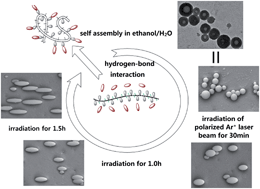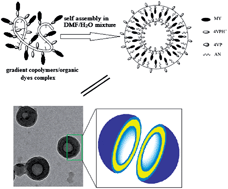5. Photo-responsive polymer nanospheres

Size controllable hollow nanospheres have been fabricated through self-assembly of polymer/azo-compound pairs in aqueous media. A unique photoinduced deformation behavior of nanospheres was observed, when the nanospheres were irradiated by a linearly polarized Ar+ laser beam.
4. size-controllable polymer nanospheres

Fabrication of size controllable polymeric hollow nanospheres with azo functional groups is of great interest for applications in biomedical engineering, electronics, optics, and diagnostics. We report here a facile and economic way of fabricating polymeric hollow nanospheres with azo functional groups using ionic self-assembly of random copolymers poly(acrylonitrile)-stat-poly(4-vinyl-pyridine) and azobenzene dye metanil yellow (MY). The size of the hollow nanospheres is homogeneous and can be conveniently controlled by varying molar ratios of the copolymers to MY and molar ratios of monomers of the copolymers. The composition of the polymeric nanospheres and the self-assembly behaviors were characterized by 1H-NMR, FTIR, UV-Vis spectrophotometry, TEM, dynamic light scattering and elemental analysis. The formation process of hollow nanospheres was considered based on the results from UV-Vis spectrophotometry and TEM. Finally, the effects of azo complex composition on the morphology of the nanospheres were discussed, and the formation mechanism of polymeric hollow nanospheres was proposed.

An inverse design methodology suitable to assist the synthesis and optimization of molecular sensitizers for dye-sensitized solar cells is introduced. The method searches for molecular adsorbates with suitable photoabsorption properties through continuous optimization of ˇ°alchemicalˇ± structures in the vicinity of a reference molecular framework. The approach is illustrated as applied to the design and optimization of linker chromophores for TiO2 sensitization, using the recently developed phenyl-acetylacetonate (i.e., phenyl-acac) anchor [McNamara et al. J. Am. Chem. Soc.2008, 130, 14329¨C14338] as a reference framework. A novel anchor (3-acac-pyran-2-one) is found to be a local optimum, with improved sensitization properties when compared to phenyl-acac. Its molecular structure is related to known coumarin dyes that could be used as lead chromophore anchors for practical applications in dye-sensitized solar cells. Synthesis and spectroscopic characterization confirms that the linker provides robust attachment to TiO2, even in aqueous conditions, yielding improved sensitization to solar light and ultrafast interfacial electron injection. The findings are particularly relevant to the design of sensitizers for dye-sensitized solar cells because of the wide variety of structures that are possible but they should be equally useful for other applications such as ligand design for homogeneous catalysis.
Inelastic electron-transfer kinetics in molecules with electron donor and acceptor units connected by a bridge is expected to be sensitive to bridge-localized vibronic interactions. Here, we show how inelastic electron transfer may be turned on and off in a double-slit style experiment that uses the molecule as an interferometer. We describe donor-acceptor interactions in terms of interfering vibronic coupling pathways that can be actively selected (ˇ°labeledˇ±) when pathway-specific vibrations are excited by infrared radiation. Thus, inelastic tunneling may be actively controlled, and we suggest strategies for building molecular scale quantum interferometers and switches based on this phenomenon.

1. Cabon Nanotube based nonlinear optical materials

Studies of the nonlinear electronic response of donor/acceptor substituted nanotubes suggest a behavior that is both surprising and qualitatively distinct from that in conventional conjugated organic species. We also find that tuning the donor orientation, relative to the nanotube, can significantly enhance the first hyperpolarizability.

